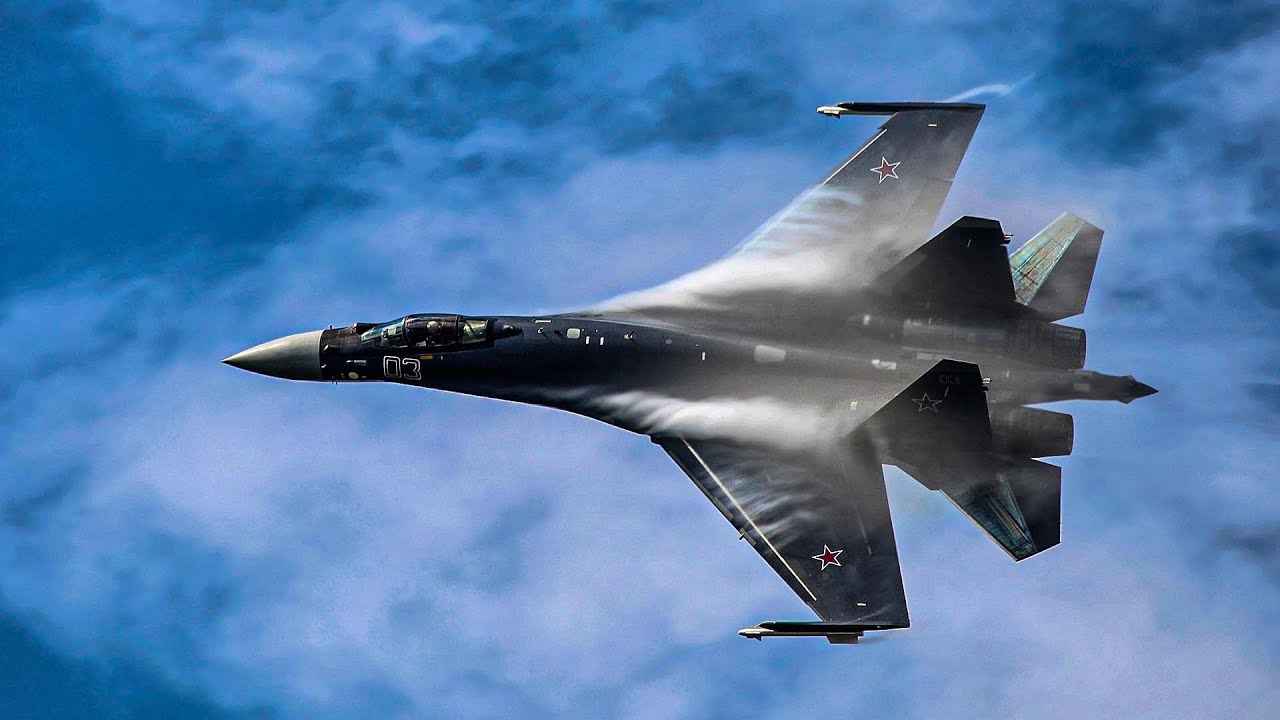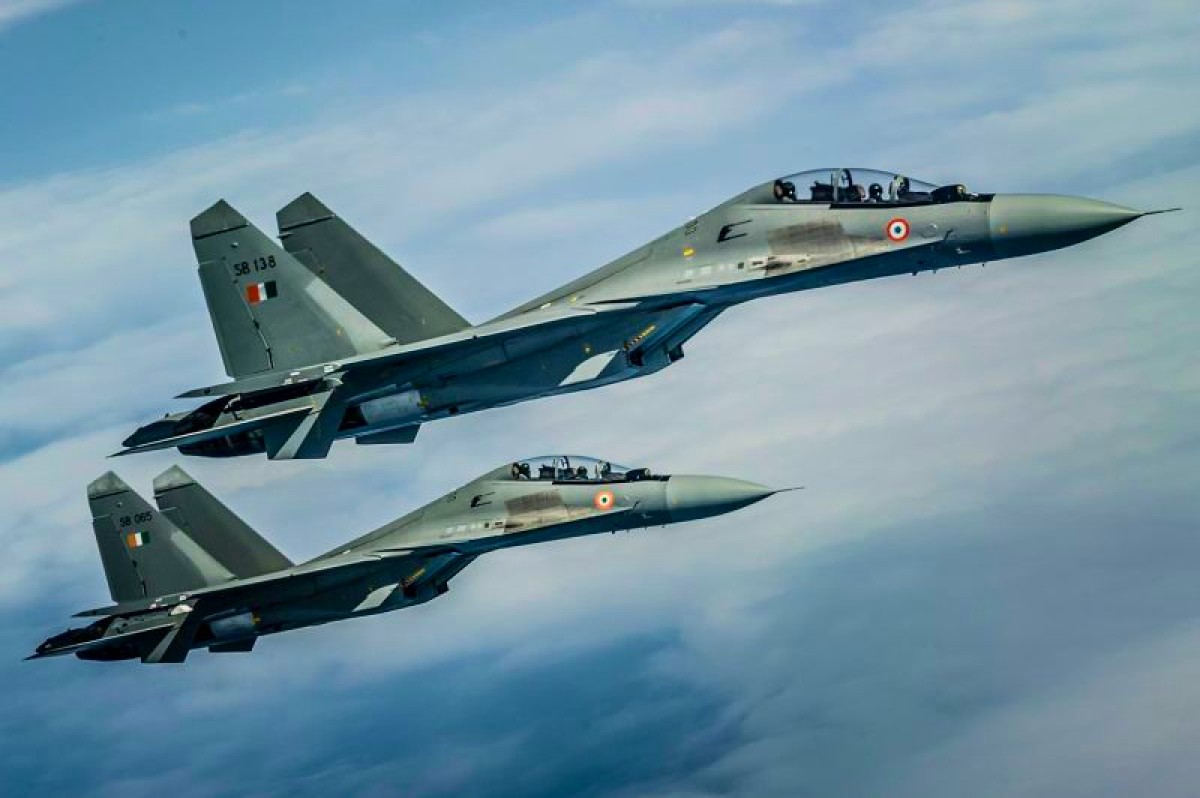At the opening of the ongoing Dubai Air Show, the crewmen of the Russian Knights aerobatic team demonstrated aerial stunts and supermaneuverable capabilities of Su-35S fighter jets during the flying display. On the same day, a senior Russian state manufacturer Rostec official stated that the jet was in great demand globally.
Deputy General Director of Russia’s arms manufacturer Rostec, Vladimir Artyakov, told reporters on November 13 that the Su-35 fighter jet was one of the many weapon platforms in the Russian inventory that saw an uptick in global demand after a successful combat record in Ukraine.
The aircraft has been extensively deployed against Ukraine since Russia launched the special military operations in February 2022.
Despite incurring some losses, the aircraft has given a hard time to Ukraine, firing long-range air-to-air missiles and forcing Ukrainian fighter jets to fly at a low altitude. Russia has reportedly been replacing its older fighter jets with the latest and more advanced Su-35 to establish a “localized air superiority” on the frontlines.
However, it has had little success even as Russia aggressively markets the Su-35 aircraft to friendly countries. There are only two operators of this supermaneuverable Russian aircraft, including the Russian Aerospace Forces and the Chinese PLA Air Force.
With a US$2 billion contract, China became the first foreign buyer of the Russian Sukhoi Su-35 in 2015. However, Beijing purchased only two dozen fighter jets for only one squadron.
The small purchase size gave rise to speculations that China may have bought these fighters to reverse engineer them to produce a 4++ generation aircraft locally.
Russia was in talks with the United Arab Emirates (UAE), with officials expressing optimism for a possible deal until a few years ago. However, while the two states have maintained a cordial relationship, making the Dubai Air Show one of the only exhibitions where Moscow is allowed, a deal for the Su-35 remains elusive.
During the Dubai Airshow 2023, Alexander Mikheev reportedly admitted that as of 2021, there had been no correspondence between Russia and the United Arab Emirates over the supply of Su-35 fighter aircraft, despite Russia’s active marketing around the Middle East.
Some pro-Ukrainian and pro-Western military commentators even took to social media to point out that claims made by Russian arms manufacturers about the Su-35 being in demand owing to its performance in Ukraine are merely an attempt at salvaging the aircraft’s reputation.
Russia’s Failed Attempt At Selling Su-35s
United Arab Emirates
The UAE and Russia signed a preliminary agreement in 2017 to purchase Sukhoi Su-35 fighters and collaborate on developing a next-generation fighter.
Back in 2017, a source told Russian TASS, “They want a lot, over a squadron, but the exact number will be specified in the course of negotiations that may be held in November during an air show in Dubai. According to some sources, the two sides stayed in touch over a potential deal but could not make a breakthrough.
During the same time, the UAE was also aiming to purchase the US fifth-generation F-35 fighter jets. However, as Washington sat on the deal owing to its concerns about an increased bonhomie between UAE and China, Riyadh signed an agreement with Dassault Aviation to buy 80 Rafale F4 jets, the latest variant of the 4.5-generation fighter aircraft.
Since both Su-35 and Rafael are 4+ generation heavy fighters, it indicated that Su-35 was off the table for the Emirati kingdom. The failure to successfully export the Su-35S to the UAE has since reflected a general decline in interest from other air forces, in an evident domino effect.
Algeria
The Russian Su-35S reportedly completed a series of tests in Algeria at the beginning of February 2016. The trials conducted at the Tamanrasset training ground included testing the radar’s characteristics, weaponry, and aerobatic capabilities.
The Algerian Ministry of Defense chose to hold off on purchasing the Su-35 until after it was put into service by the Russian Aerospace Forces and until the first export orders were received.
There were reports in local media that Algeria was looking at a potential purchase order of 18 aircraft. However, despite speculations making rounds, no official announcement was made by either side.
However, a deal for Russia’s Su-35 fighters failed to come through. A few years later, Algeria reportedly signed a deal for additional Su-30MKA and MiG-29 fighters instead. This was touted as an end of the country’s interest in the Russian Su-35 Flanker E. There has been no update on the purchase since.
Egypt
Egypt placed an order for 24 Sukhoi Su-35S heavy fighters in 2018. Russia’s Kommersant Daily announced in March 2019 that Egypt had ordered two dozen Su-35 fighter jets for about US$2 billion.
“The agreement for the supply of ‘over two dozen aircraft’ and aviation aids will amount to US$2 billion. The contract was signed at the end of 2018, and the aircraft delivery beginning as early as 2020-21.”
However, enraged by the purchase, former US State Secretary Mike Pompeo threatened to put sanctions on Egypt under the Countering America’s Adversaries Through Sanctions Act (CAATSA) if the transaction proceeded.
Nevertheless, Russia continued to produce the aircraft, and in July 2020, the first batch completed its flight tests. While traveling from the Komsomolsk-on-Amur Aircraft Plant, the first five Sukhoi Su-35 fighters from the Egyptian Air Force were photographed at Novosibirsk Tolmachevo Airport. However,
Egypt eventually withdrew from the agreement, and Russia was left with two dozen Su-35s with nowhere to go.
Indonesia
Indonesia was offered the Su-35 by Russia in 2014 as a replacement for its aging F-5E Tiger II fleet. The Indonesian Ministry of Defense chose the Su-35 over the Eurofighter Typhoon, Dassault Rafale, F-16, and Saab JAS 39 Gripen the following year.

The Indonesian defense ministry justified the Su-35’s decision, citing the Indonesian Air Force’s experience with the Su-27SK and Su-30MK2.
The Su-35 talks had progressed to an advanced stage by 2017, and the Indonesian government had subsequently agreed in principle to sell agricultural products for eleven aircraft through barter.
Russia and Indonesia signed a US$1.14 billion deal in February 2018 to purchase 11 aircraft. The initial delivery was supposed to happen in October 2018. However, it was delayed to 2019.
However, under pressure from the United States and fearing sanctions, Indonesia eventually pulled the plug on the prospect of buying Su-35 from Russia in 2021. It has since signed contracts for French Rafales and US F-15EX fighter jets.
Turkey
After Turkey was dropped from the F-35 program by the United States because it had purchased the S-400 missile system, Russia offered Turkey a Su-35 in July 2019. The then-CEO of Rostec, Sergey Chemezov, said, “If our Turkish colleagues express a desire, we are ready to work out the deliveries of Su-35 fighter jets.”
Turkish Presidency of Defense Industries chief Ismail Demir said in October 2021 that Turkey could acquire Russia’s Su-35 and Su-57 fighters if the US freezes the sale of F-16 fighter jets. However, still hopeful for approval over the sale of F-16s by Washington, Ankara did not give a green light to the Russian Su-35s.
As tensions continued to peak, in January this year, the country went so far as to iterate that it was considering multiple options, including the Eurofighter Typhoon, the French-made Rafale fighter jet, and the Russian-made Su-35.
Eventually, as Turkey allegedly held Sweden’s membership of NATO for ransom, the United States caved in. It announced that US President Joe Biden’s administration would transfer F-16 fighter jets to Turkey in consultation with the US Congress.
India
After the potential deals for the sale of Su-35 fell off with Algeria, Egypt, and Indonesia, Russia looked hopefully towards the largest buyer of its arms, India. The Indian Air Force (IAF) is in the process of acquiring 114 multi-role jets.

While the French-made Rafale seems to be in the lead, as revealed by a widely-circulated survey previously conducted by The EurAsian Times, India’s old friend Russia is also hoping to secure this contract. Moscow offered the IAF two alternative fighter aircraft, including the Sukhoi-35 and the MiG-35.
To make the deal sweeter for India, Russia is believed to have offered a variety of Su-35 technology under the contract that can be utilized to upgrade India’s Su-30 fleet, significantly improving their performance.
However, the IAF has yet to select a fighter jet, and the Su-35 is not leading the race.
Vietnam
Some sources within Russia’s Federal Service of Military Technology Cooperation earlier told the Russian daily Kommersant that the Vietnam People’s Air Force was reportedly interested in acquiring a squadron of Sukhoi Su-35S multirole fighter fighters.
The insider source disclosed that Russia and Vietnam were reportedly negotiating to sign a new arms contract valued at approximately US$1 billion, which might involve delivering up to 12 of the 4++ generation aircraft. However, this deal never went through, and soon the reports and speculations also dissipated.
In October this year, reports suggested that Vietnam was in talks with the US to purchase F-16 fighter jets after consummating their newly upgraded partnership.
Iran
In January this year, Iranian officials revealed that they had ordered 24 Russian 4.5-generation, twin-engine Su-35 fighters and anticipated receiving them in three months. This was seen as the peak of the Russia-Iran defense partnership after the latter armed Moscow with Shahed-class kamikaze drones in its fights against Ukraine.
It was reported that Iran would receive the batch of 24 Su-35 fighter jets originally produced for Egypt.
Shahriar Heidari, a member of the parliament’s National Security Committee, said the jets will arrive in Iran during the Iranian new year, which typically starts on March 21. However, several months after that announcement, the Russian Su-35s are yet to be delivered to the Iranian Air Force, causing suspicion that the deal has fallen apart.
The speculations were rife in July when Iran’s defense minister Mohammad-Reza Gharaei Ashtiani said the state could manufacture combat aircraft at home. According to Iranian media and experts, the statement implied a potential change. Reluctant to provide more details for security reasons, Ashtiani said, “At some point, we made a deal for the purchase, but we came to the conclusion that we can produce (fighter jets) in the country.”
In early September, reports said Russian-made YAK-130 combat trainer aircraft had joined the Iranian Air Force. While some experts read this as indicating that the Su-35 deal was very much on, some have expressed pessimism about the agreement. The status of the delivery remains unknown as of now, at a time when the region has erupted into violence against the backdrop of Israel’s bombing of Gaza.
Russia’s hope of exporting the Su-35 is hanging by a thread as it participates in the Dubai Air Show again this year and markets its aircraft to potential players.
When asked why it has been challenging to sell the jet that has shown excellent combat performance, Indian Air Force veteran and keen Russian military watcher Squadron Leader Vijainder K. Thakur told EurAsian Times, “The market for heavy fighters is minimal.”
- Contact the author at sakshi.tiwari9555 (at) gmail.com
- Follow EurAsian Times on Google News




